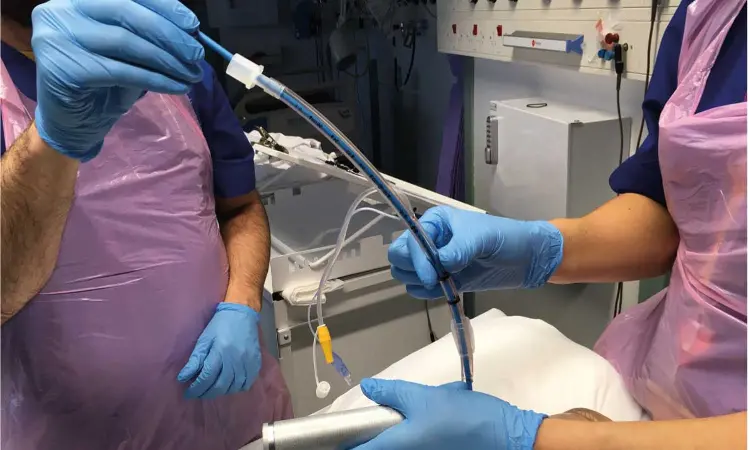- Home
- Medical news & Guidelines
- Anesthesiology
- Cardiology and CTVS
- Critical Care
- Dentistry
- Dermatology
- Diabetes and Endocrinology
- ENT
- Gastroenterology
- Medicine
- Nephrology
- Neurology
- Obstretics-Gynaecology
- Oncology
- Ophthalmology
- Orthopaedics
- Pediatrics-Neonatology
- Psychiatry
- Pulmonology
- Radiology
- Surgery
- Urology
- Laboratory Medicine
- Diet
- Nursing
- Paramedical
- Physiotherapy
- Health news
- Fact Check
- Bone Health Fact Check
- Brain Health Fact Check
- Cancer Related Fact Check
- Child Care Fact Check
- Dental and oral health fact check
- Diabetes and metabolic health fact check
- Diet and Nutrition Fact Check
- Eye and ENT Care Fact Check
- Fitness fact check
- Gut health fact check
- Heart health fact check
- Kidney health fact check
- Medical education fact check
- Men's health fact check
- Respiratory fact check
- Skin and hair care fact check
- Vaccine and Immunization fact check
- Women's health fact check
- AYUSH
- State News
- Andaman and Nicobar Islands
- Andhra Pradesh
- Arunachal Pradesh
- Assam
- Bihar
- Chandigarh
- Chattisgarh
- Dadra and Nagar Haveli
- Daman and Diu
- Delhi
- Goa
- Gujarat
- Haryana
- Himachal Pradesh
- Jammu & Kashmir
- Jharkhand
- Karnataka
- Kerala
- Ladakh
- Lakshadweep
- Madhya Pradesh
- Maharashtra
- Manipur
- Meghalaya
- Mizoram
- Nagaland
- Odisha
- Puducherry
- Punjab
- Rajasthan
- Sikkim
- Tamil Nadu
- Telangana
- Tripura
- Uttar Pradesh
- Uttrakhand
- West Bengal
- Medical Education
- Industry
Nasal protection prevents nasal pressure injury from nasotracheal intubation

A new study conducted by Hiroshi Hoshijima and team found that nasal pressure damage during nasotracheal intubation is considerably decreased by a nasal protection technique. The findings of this study were published in Medicine Journal.
Nasotracheal intubation is mostly used to maintain long-term artificial breathing and to secure the airway during oral or head and neck surgery. The tracheal tube's constant pressure on the nasal columella and ala during nasotracheal intubation typically results in local ischemia between them. Nasotracheal intubation poses a high risk for nasal pressure damage. In order to ascertain if the adoption of a nose protection strategy (a protective dressing or a modified fastening method for the tracheal tube) lowers the incidence of nasal pressure injury during nasotracheal intubation, researchers conducted this systematic review and meta-analysis.
Three electronic databases were used for the literature searches. DerSimonian and Laird random effects models were used to aggregate the data from all of the eligible trials and perform the computations. The Cochrane Q statistic, the I2 statistic, and the relative risk and 95% confidence interval were used to assess the pooled effect estimates for nasal pressure injury. TSA was also carried out to evaluate the sensitivity to guard against type I mistakes. To determine the frequency of nasal pressure damage based on whether a protective dressing or a modified fixation technique for the tracheal tube was utilized, patients were divided into subgroups.
The key findings of this studies were:
1. Five trials that met the criteria were found in the literature.
2. A nose protection technique considerably decreased the incidence of nasal pressure damage during nasotracheal intubation, according to a meta-analysis of these trials.
3. Due to a small sample size, it was not possible to compute the TSA threshold for futility.
4. Both techniques considerably decreased the frequency of nasal pressure damage during nasotracheal intubation in subgroup analysis.
In conclusion, the frequency of nasal pressure injuries during nasotracheal intubation can be reduced by using a protective bandage or a modified anchoring technique for the tracheal tube. Further research is necessary because the number of samples in our meta-analysis was insufficient for TSA.
Reference:
Hoshijima, H., Mihara, T., Nagumo, T., Sato (Boku), A., Shiga, T., & Mizuta, K. (2022). Nasal protection strategy reduces the incidence of nasal pressure injuries during nasotracheal intubation: Meta-analysis with trial sequential analysis. In Medicine (Vol. 101, Issue 40, p. e30638). Ovid Technologies (Wolters Kluwer Health). https://doi.org/10.1097/md.0000000000030638
Neuroscience Masters graduate
Jacinthlyn Sylvia, a Neuroscience Master's graduate from Chennai has worked extensively in deciphering the neurobiology of cognition and motor control in aging. She also has spread-out exposure to Neurosurgery from her Bachelor’s. She is currently involved in active Neuro-Oncology research. She is an upcoming neuroscientist with a fiery passion for writing. Her news cover at Medical Dialogues feature recent discoveries and updates from the healthcare and biomedical research fields. She can be reached at editorial@medicaldialogues.in
Dr Kamal Kant Kohli-MBBS, DTCD- a chest specialist with more than 30 years of practice and a flair for writing clinical articles, Dr Kamal Kant Kohli joined Medical Dialogues as a Chief Editor of Medical News. Besides writing articles, as an editor, he proofreads and verifies all the medical content published on Medical Dialogues including those coming from journals, studies,medical conferences,guidelines etc. Email: drkohli@medicaldialogues.in. Contact no. 011-43720751


